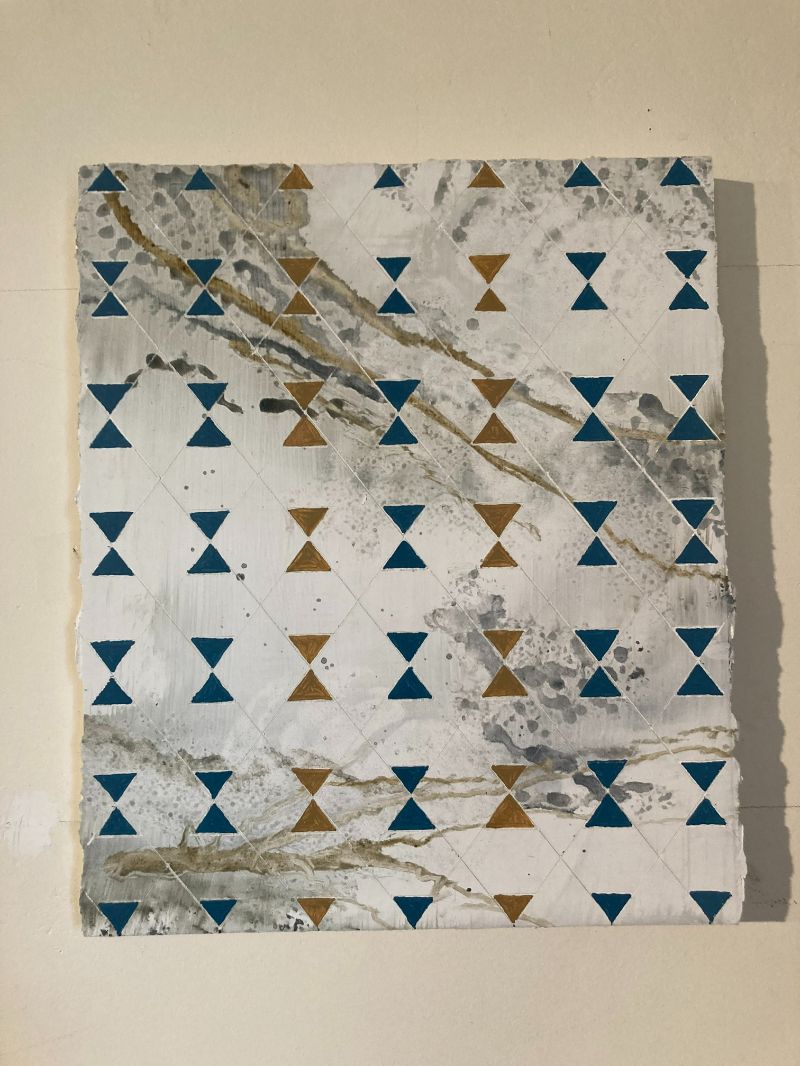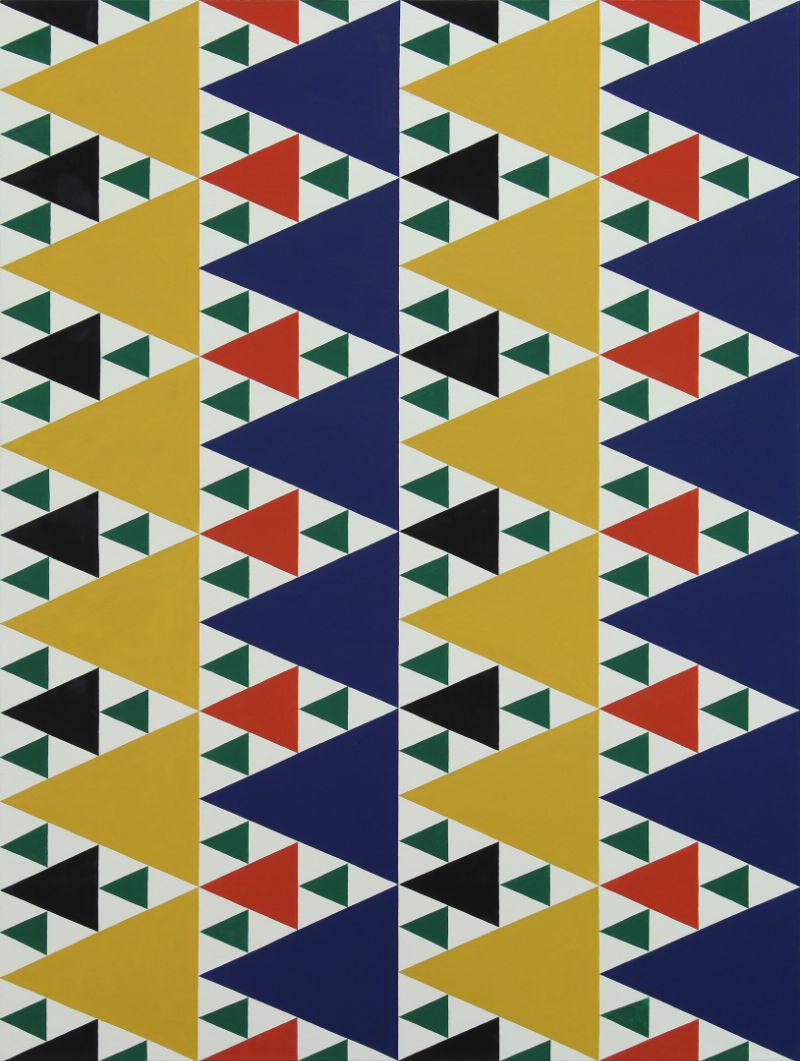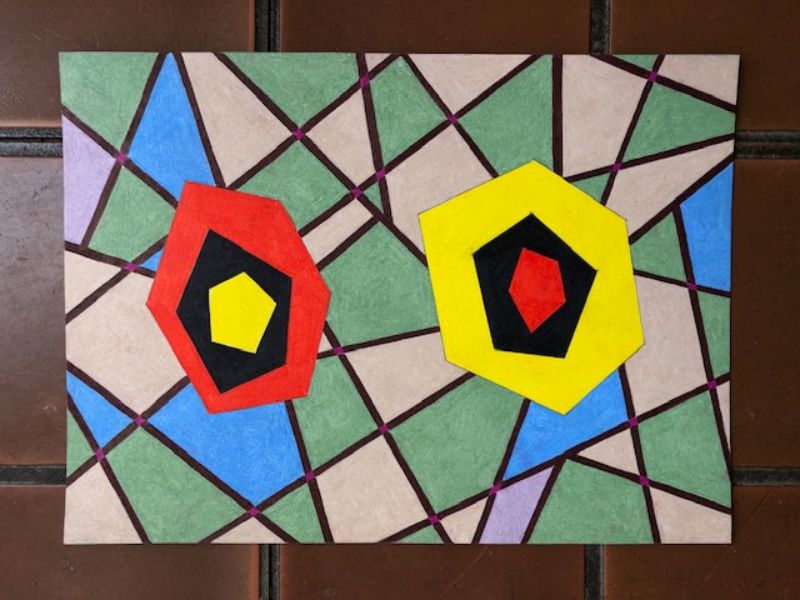calendar | past | statement | artists | proposals | contact
1395 Boston Corners Rd, Millerton NY 12546
Pattern and Time
Carol Diehl, Tara Foley, Moira Kelly,
Mark Olshansky, Stephen Westfall *, Geoffrey Young
May 7th to June 25th
Opening May 7th 5pm to 8pm, with potluck
The six artists included in this show all deal with the base element of pattern in their art. Base elements are things like oxygen or lead. They are the parts that we build upon. When looking at these works it is possible to see the beginning of language and communication. The start of a dialogue between the painter and the painted,
the drawing and the line. Each of these artists tries to connect themselves to the patterns that they find themselves making. I suggest that the viewer try to feel the way one shape interacts with its neighboring shape.
I had hoped that the work in this exhibition would tell the story of artmaking within the lives of each of these artists. I had hoped that the difficulty of beginning the making of work would be apparent. And that the device of pattern could be seen as a solution to this difficulty. I think this group of works do show the fundamental base at which we humans relate to geometric forms. Early humans lived in the natural world which is chaotic. They needed to decipher this chaos. They needed to find the patterns in the chaos. This is our deep historic drive to feel comfort through patterns. Sometimes we break patterns and sometimes we flow into patterns.
The second half of the title of this show is “Time”. Time is how we all deal with the creation and destruction of the patterns that we find. Time is how these artists have repeatedly reached out to pattern to create order. The time part is old and familiar. The viewer may find it helpful to slow down when looking at these pieces of art. Try to feel the relationships of the layers of pattern and the breaks in those patterns. This work is not talking about politics or opinion. It is talking about contentment and beauty.
* Stephen Westfall’s work courtesy of Alexandre Gallery
________________________________________________________________________
Artists’ Statements:
Carol Diehl is a painter who marries the literal with the abstract in a futile attempt to find balance between order and chaos. The literal could be notations indicating specific events or emotions in a calendrical manner, or obliterated with a grid or gesture in an attempt not to reveal (or remember) too much. Is a painting finished? Sometimes…while other times it becomes a jumping off point for further inquiry.This is all about life in flux, where we try to look through the layers to figure out what’s happening and find…more layers.
%20o-c,%20120x96_2002.jpeg)
Carol Diehl, Resolutions (Blue Quad) ________________________________________________________________________
Tara Foley There has always been a relationship between pattern and language. For enjoyment, I have been a student of Japanese on and off for many years. The older works (from 2020) in this grouping came out of an intense reinvestment in learning the language and I didn't realize until later the connection. I have learned that acquiring a new language invigorates the mind in ways that I didn't quite understand and could only begin to express through painting patterns. The patterns are an actual language in themselves, each shape symbolizes a letter, so each pattern is a phrase. I am able to create a secret language through these patterns. The things I am trying to communicate through patterns are centered around ethics and humanity and are meant to be read and understood by the coming AI.
The works from this year 2022, explore something different entirely as related to pattern. I'm thinking about the materials of makers that may not usually be seen in gallery spaces, but in people's homes. such as decorative tape, modge podge, pen, etc. I became interested in the term "junk journal" and the materials used for those types of works. These works utilize those same materials and ask the question, who is meant to inhabit gallery spaces and walls?
.jpg)
Tara Foley, Loveletter
________________________________________________________________________
Moira Kelly The paintings are all on panel, with up to four coats of an acrylic-plaster mix. This is etched with a sharp point to create a pattern or a variety of shapes, often corresponding to the trowel marks in the plaster. These shapes are painted or stained with heavily pigmented tempera paint and finally varnished or polished with wax. The paintings are meant to be felt as well as viewed and can come to no harm by being held or mounted on a shelf. The impetus for this work comes from my studies of painting techniques, geology and medieval manuscript illuminations. Many of the images relate to weaving and patchwork design.

Moira Kelly, Trawler
_____________________________________________________________
Mark Olshansky Needlepoint is my work. I pick a piece of light or dark wool and sew MO. In the right hand corner and it’s off to the races. Each line, color, shape, connection, separation, relationship, extension, density, stitch is a new decision and once it’s made there’s no going back. It doesn’t matter. With three hundred million people in this country alone, someone is going to say, ”I like that“. I find recurring patterns ending up in finished work are not conscious decisions. I consider them “style”. If I suspect a pattern forming I’ll take another road if possible. Often it’s too late. The road has been lengthy, often veering in new directions. It’s all been sticky stuff though and certainly affects current efforts.
.jpg)
Mark Olshansky
Frozen Flying Kippers in the Icy Mist with Candied Spareribs and Dandruff
________________________________________________________________________
Stephen Westfall *
Stephen Westfall’s (American, b. 1953) paintings have charted a course between post-minimalist geometries and a Pop inflected awareness of a painting as a thing in the world. The brightly colored diamonds, triangles and trapezoids in his most recent canvases are conjoined into dynamic compositional skeins that seem to lean into space rather than recede. Drawing on Caucasian and Navajo rugs, medieval heraldry, Byzantine floor tile, early twentieth century abstraction, architecture and Pop, Minimalist and post-minimalist painting, Westfall’s abstraction is deeply acculturated while formally honed into an active, perceptual immediacy.

Stephen Westfall, High Plains
* Stephen Westfall’s work courtesy of Alexandre Gallery
________________________________________________________________________
Geoffrey Young Something always pops in my head the minute I see a blank piece of paper. If the paper is square, I get a square idea. If rectilinear, something longer than it is wide screens in my bean. Then it’s just urging the lines along on their fateful way into the drawing, taking whatever chances seem appealing at the moment. If a straight-edge is required, so be it. If swirling freehand shapes appear, why not? Permission arm-wrestles with capacity. (Every golf-course has its sand-traps.) But the more dangerous fun begins when the drawing is complete and it’s time to add color. Color can simplify, or challenge; it can tame density, or transform blank nuggets into fool’s gold. Often, it comes down to the last few colors added. If I like the drawing, I turn it over and sign it.

Geoffrey Young, Couple #2
_____________________________________________________________
Bios of the Artists:
Carol Diehl
One-person exhibitions of Diehl’s paintings include the Berkshire Museum (Pittsfield, MA) in 2010, Richard Sena Gallery (Hudson, NY) in 2006, Gary Snyder Fine Art i(NYC) in 2002, and Hirschl & Adler Modern (NYC) in 1996 and 1998. Diehl's paintings have been shown in group exhibitions at, among others, the Queens Museum of Art, the Aldrich Museum (CT), the Sidney Janis Gallery and the traveling museum exhibition entitled "New Directions" curated by Sam Hunter. Reviews of her work have appeared in Art in America, ARTnews, the New York Times, New York, the Village Voice, the New Art Examiner, the Chicago Sun-Times, the Chicago Tribune, and the Chicago Daily News. Diehl is the recipient of artists' fellowships from the New York Foundation for the Arts, the Pollock-Krasner Foundation, the MacDowell Colony for the Arts and the Millay Colony for the Arts.
Also known as an art critic and poet, Diehl is author of the book, Banksy: Completed, recently published by The MIT Press. A longtime Contributing Editor for Art in America, she wrote cover stories on Robert Irwin, Wolfgang Laib, Christian Marclay and Olafur Eliasson. Diehl's writing has also been published in ARTnews, New York, Art & Auction, Art & Antiques (Contributing Editor 1984-1995), Metropolis, Review, Arts, and the New Art Examiner (founding Managing Editor). In 2011 she received a Creative Capital/Andy Warhol Foundation grant for her blog, Art Vent.
Diehl has read her poetry in performance at St. Mark's Poetry Project, the Knitting Factory, and the Nuyorican Poets Cafe, as well as appearing with Butch Morris's "Chorus of Poets" at The Public Theater, the Whitney Museum and the Bang on a Can Festival at Lincoln Center. Her poetry is included in the anthology Aloud: Voices from the Nuyorican Poets Cafe (Henry Holt and Company), winner of the 1994 National Book Award.
She has contributed essays to several books including Olafur Eliasson Studio’s Unspoken Spaces (2016) and Spatial Experiments (2014), Along a Long Line about painter Michael Glier (2009), and A Place for the Arts: The MacDowell Colony, 1907-2007 (2007).
Diehl taught in the Graduate Fine Arts Program of the School of Visual Arts in New York from1996-2006, and served on the Core Faculty at Bennington College from 1998-2002. She has been a Visiting Artist and lectured at, among others, Yale University (Graduate Sculpture), Stanford University, the Graduate School of Fine Arts at the University of Pennsylvania (Senior Critic), Columbia College (Chicago), Rochester Institute of Technology, the University for the Creative Arts, Canterbury, U.K., the University of Iowa, Massachusetts College of Art, the Fine Arts Work Center in Provincetown (MA), the Vermont Studio Center, and in 2006 was the Forkosh-Hirschman lecturer at Arizona State University.
A longtime Manhattan resident, Diehl now lives and works in southwestern Massachusetts.
Tara Foley
Tara received her BA from Sarah Lawrence College in NYC, studying psychology and art. After spending 4 years in Japan and India, a time she credits as being highly inspirational and prolific, she later returned to the US where in addition to producing her own work she also teaches art to inner city youth at the Boys and Girls Club of San Francisco.
She counts her participation in San Francisco’s Low Gallery exhibition ‘Lost Civilization’ as one of the most important for her. Through it she began working on the collaborative ‘Excavation Project’ by which multi-media artists (re)create remains of extinct civilizations through ‘excavation’.
Tara works in gouache on paper through which she addresses ideas of science fiction, psychology and the unconscious.
Moira Kelly is from England and graduated from the University of Newcastle upon Tyne with an Honors degree in painting and art history. She has worked as a painting conservator at The Metropolitan Museum of Art and for other museums and private collections. Her work as a decorative painter and restorer has led her to many prestigious clients, including James Taylor, Glenn Close and Anne Bass. She was commissioned by HRH Prince Charles and Princess Diana to curate the contemporary art selection for Britain Salutes New York. As a curator Moira is best known for her introductions of new talent. She discovered Andy Goldsworthy and gave him his first show.
Moira has appeared in film documentaries about Andy Goldsworthy and Sean Scully.
Mark Olshansky I was born in Brooklyn, N.Y., was educated, drafted, married, started a family and went into business. At about my fortieth year, a friend introduced me to needlepoint at a party. It was meant to be a light-hearted accompaniment to the more serious activity of downing martinis with stylish canapes. Ten years later, I had created many tapestries, pictures, a large rug, and more. Everything was designed as I went along and was made from persian wool.
In 1980 I stopped my art when my wife and I decided to wet our toes in the wine importing world. Twenty years later, we retired, and I immediately picked up where I had left off. The procedure and material are the same today. In the past ten years I have produced many pieces of various sizes, and I have exhibited in over 100 shows, both juried and galleried. My favorite way of working is creating pieces in series, such as Art and the Fugue, Mahler and Infant series.
Geoffrey Young has lived in Great Barrington, Massachusetts since 1982. From 1992 til 2018 he presented hundreds of shows of contemporary art at the Geoffrey Young Gallery. His small press, The Figures (1975-2005), published more than 135 books of poetry, art writing, and fiction. Recent chapbooks of his poetry, prose and colored pencil drawings include Thirty-Three (above/ground press, 2017), DATES, MONEY, and PIVOT. Young has written catalog essays for a baker’s dozen of artists.
Stephen Westfall received his MFA in 1978 from the University of California, Santa Barbara. His first solo exhibition in 1984 at Tracey Garet in New York’s East Village earned reviews that took note of his particular brand of geometric abstraction. Exhibitions followed during the 1980s and into the 1990s at Daniel Newburg Gallery in New York, Galerie Paal in Munich, Germany and Galerie Wilma Lock in St. Gallen, Switzerland. An exhibition of paintings took place at Andre Emmerich Gallery in New York in 1995, followed by several exhibitions at Galerie Zurcher in Paris and a long representation by Lennon, Weinberg Gallery in New York before the gallery closed in 2019. Westfall is represented in New York by Alexandre Gallery with whom he had his debut exhibition in the fall of 2021. Recent work has been exhibited at Gisela Clement Galerie in Bonn, Germany, and Robischon Gallery in Denver, Colorado. His public art has been exhibited to wide acclaim at the McNay Museum in San Antonio; Solvent Space in Richmond Virginia; Art OMI in Ghent, NY; and the Museum of Art, Architecture & Design at UCSB. His sweeping glass encasements for the mezzanine of the 30th Ave. MTA station in Astoria, Queens has been the recipient of both state and national architectural awards. Westfall is a professor at the Mason Gross School of the Arts at Rutgers University. He is a contributing editor at Art in America.
_______________________________________________________
Links:
Carole Diehl
Tara Foley
Moira Kelly
Mark Olshansky
Stephen Westfall
Geoffrey Young